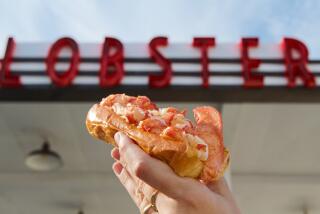Master Class: Michael Cimarusti teaches you how to prepare lobster
I ate my share of lobsters while spending summers in Rhode Island. My family still talks about the 10-pounder we bought from a shop in Galilee. We spent an hour scouring the neighborhood looking for someone who owned a pot big enough to cook it. Lobster is still one of my favorite foods of summer — that’s when it is the cheapest, when they move closer to shore and the fishing conditions are better.
A good lobster is something to be relished, eaten with your hands, the buttery juices wiped from your chin and licked from your fingers.
The easiest way to cook lobster is simply boiled and then served on a picnic table spread with newspaper. Select a pot that is large enough to accommodate all the lobsters. Add enough salt to the water to approximate the salinity of the sea, about 3.5%. Add enough vinegar that the water tastes slightly acidic.
Bring the water to a boil, add the lobsters and cover the pot. The water should maintain a simmer but no more — that makes more tender meat. The general rule for cooking lobster is to allow 7 to 8 minutes per pound. I think lobster tends to be better when slightly less than fully cooked, but most people want their shellfish well done. This is totally understandable, but a hint of translucence in the flesh is not a bad thing.
After you’ve cooked the lobsters, you should cut them in half before serving. This can be quite messy, so you should surround your cutting board with paper or old kitchen towels to contain the mess.
To split a lobster, begin by centering the tip of a sharp knife at the point on the back of the lobster where the head or carapace meets the tail. Pierce the shell and drive the tip of the knife straight through the tail to the cutting board. Be sure the tail is lying flat on the cutting board and cut through it, pushing on the back of the knife with your free hand as well as pressing down with the knife hand. To cut the head in half, repeat the process in the other direction, starting out with your knife in the same place. Use the back of the knife to crack the claws.
Once the lobsters are halved, remove the digestive tract and the creamy green tomalley. If there is dark green roe in your lobsters, make every effort to leave it undisturbed. This is why you buy female lobster, and it is a true delicacy. (You can tell female lobsters because the first two legs, or “swimmeretes,” closest to the head will be soft and flexible.)
It’s easy to cook lobster on the grill. Boil it briefly first to partially cook it and set the meat. Split the lobster and brush the cut side generously with herb butter. Start grilling with the lobster shell side down for the first two to three minutes of cooking. This will help finish the cooking of the lobster and will also impart a stronger lobster flavor.
Once you flip the lobsters over, lightly brush the shells with a touch of the herb butter and season them with sea salt. Cook the lobster flesh side down for another two to three minutes. Don’t try to move it — lobster is delicate and loves to stick to grills.
If you want a real Rhode Island treat, make a lobster roll. The best thing to do is start with cull lobsters. Ask your fishmonger for them. They’re the lobsters that are missing at least one claw, so they’re sold at a lower price. You want lobsters that weigh less than 11/2 pounds each. Since you can count on a lobster to deliver about 25% of its live weight in cooked meat, if you start with 5 pounds of live lobsters, you’ll end up with about 11/4 pounds of meat — enough for four very generous rolls.
Use just enough mayonnaise to coat the meat. Too little mayonnaise and the lobster roll will taste flat, too much and the roll won’t taste of lobster.
If you have too much lobster for the four rolls, consider yourself lucky. Either serve it alongside in a lettuce cup or put it in the fridge and make yourself a lobster roll for breakfast.
More to Read
Eat your way across L.A.
Get our weekly Tasting Notes newsletter for reviews, news and more.
You may occasionally receive promotional content from the Los Angeles Times.






